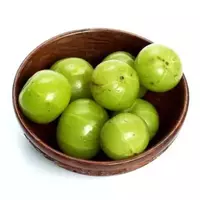Medicinal emblem

The plant phyllanthus emblica or Phyllanthus emblica belongs to fruit trees from the genus Phyllintus. Often phyllantus is called amla, Indian gooseberry, amalaki, as well as medicinal emblem. In its appearance and biological structure, the medicinal emblem is a semi-deciduous tree, which often reaches 30 meters in height.
The trunk of the medicinal emblem is covered with gray-brown bark. the plant has a rather compact size of its oblong leaves. The fruits of the medicinal emblem really resemble something, well-known and widespread in our latitudes, gooseberries. The green fruits of the medicinal emblem become yellowish during active ripening.
Usually, the fruits of the medicinal emblem do not exceed 3 mm in width. Inside the fruits is a juicy and crispy flesh in which you can find small seeds. Researchers are confident that the birthplace of the emblem can be considered the region of Southeast Asia. Currently, medicinal emblem is actively cultivated in countries such as Pakistan, Malaysia, China, India, Sri Lanka and Thailand.
The most widespread emblem was in folk Indian medicine or Ayurvedic teaching. Emblem fruits are eaten fresh, and in addition are used in the preparation of various medicinal and healing products. For example, the fruits of the emblem are included in the Indian mixture of medicinal plants Chavanprash.
This world-famous Indian food supplement is more composed of the flesh of emblica fruits. In addition, up to 80 different useful ingredients are included in the composition of the natural drug. In the first, such medicine as Chavanprash is mentioned in the Rigveda or "veda of hymns, " dating from 1700-1100 BC.
Already in those distant ancient times, people actively used the fruits of the emblem for food, as well as as a medicine. The amla or emblem plant is considered a natural rejuvenating agent, which in addition contains a colossal amount of compounds useful for the human body.
In the chemical composition of the emblem, you can find such biologically active compounds as nicotinic acid, thiamine bromide, tannin, glucose, carotene, albumin, as well as gallic acid, phosphorus, calcium and iron. The uniqueness of the chemical composition of emblem fruits lies in the content of a high amount of vitamin C.
The fruit of the medicinal emblem plant contains 30 times more vitamin C than oranges. What is even more unique is the ability of the emblem, even in dried form, to keep its taste and consumer characteristics unchanged for three years. Moreover, the vitamin-mineral composition of the plant is also preserved due to the balance and high stability of all useful compounds with which the fruits of the medicinal emblem are enriched.
medicinal emblem 45 kCal
Energy value of the medicinal emblem (Ratio of proteins, fats, carbohydrates - ju):
Proteins: 0.7 g (~ 3 kCal)
Fats: 0.2 g (~ 2 kCal)
Carbohydrates: 9.1 g (~ 36 kCal)
Energy ratio (bj | y): 6% | 4% | 81%
 Español
Español Français
Français Português
Português Русский
Русский 简体中文
简体中文 繁體中文
繁體中文 日本語
日本語 한국어
한국어 العربية
العربية Türkçe
Türkçe Қазақ
Қазақ Deutsch
Deutsch Italiano
Italiano Українська
Українська
